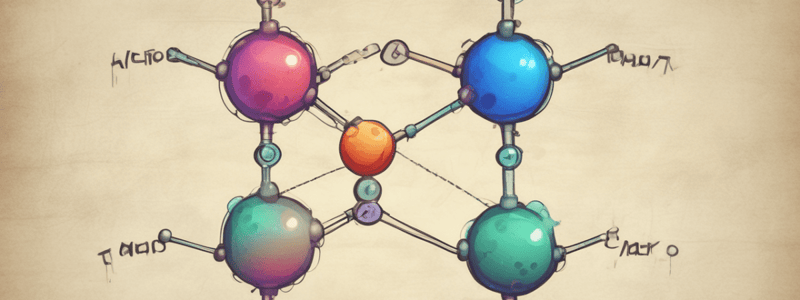Podcast
Questions and Answers
Which term describes a compound that can accept an electron pair from an electron pair donor in Lewis acid-base theory?
Which term describes a compound that can accept an electron pair from an electron pair donor in Lewis acid-base theory?
- Lewis acid (correct)
- Proton donor
- Electronegative center
- Bronsted acid
In Lewis acid-base theory, what is the role of a Lewis base?
In Lewis acid-base theory, what is the role of a Lewis base?
- Electron pair donor (correct)
- Electronegativity enhancer
- Proton acceptor
- Sigma bond breaker
Which of the following correctly describes a Lewis acid without requiring high electronegativity?
Which of the following correctly describes a Lewis acid without requiring high electronegativity?
- Sulfuric acid
- Oxalic acid
- Hydrochloric acid
- Carbocation (correct)
Which compound can act as a Lewis acid without being highly electronegative?
Which compound can act as a Lewis acid without being highly electronegative?
What is the defining characteristic of a Lewis base in terms of electronegativity?
What is the defining characteristic of a Lewis base in terms of electronegativity?
Which of the following is an example of a common Lewis base that is not highly electronegative?
Which of the following is an example of a common Lewis base that is not highly electronegative?
What characterizes Lewis acids?
What characterizes Lewis acids?
Which of the following is a Lewis acid based on the provided information?
Which of the following is a Lewis acid based on the provided information?
What distinguishes Lewis bases from Lewis acids?
What distinguishes Lewis bases from Lewis acids?
Which of the following is NOT a Lewis base according to the text?
Which of the following is NOT a Lewis base according to the text?
What category can Lewis acids be classified into based on their reactivity with Lewis bases?
What category can Lewis acids be classified into based on their reactivity with Lewis bases?
Which of the following is NOT an example of a Lewis acid from the information provided?
Which of the following is NOT an example of a Lewis acid from the information provided?
What role do Lewis acids play in catalysis?
What role do Lewis acids play in catalysis?
What type of bond is formed in a Lewis acid-base reaction?
What type of bond is formed in a Lewis acid-base reaction?
How are Lewis acids and bases classified based on their reactivity?
How are Lewis acids and bases classified based on their reactivity?
What determines the hardness of a Lewis acid or base?
What determines the hardness of a Lewis acid or base?
In the context of hard acids and bases, what type of bonds do hard acids form with hard bases?
In the context of hard acids and bases, what type of bonds do hard acids form with hard bases?
What type of complex is formed in a Lewis acid-base reaction?
What type of complex is formed in a Lewis acid-base reaction?
Why are Lewis acids and bases considered crucial concepts in chemistry?
Why are Lewis acids and bases considered crucial concepts in chemistry?
What framework do the hard and soft categories provide in understanding chemical reactions?
What framework do the hard and soft categories provide in understanding chemical reactions?
Which factor influences whether a Lewis acid is classified as hard or soft?
Which factor influences whether a Lewis acid is classified as hard or soft?
Which species is NOT listed as an example of a Lewis base in the text?
Which species is NOT listed as an example of a Lewis base in the text?
What type of Lewis base is Pyridine and its derivatives known to be?
What type of Lewis base is Pyridine and its derivatives known to be?
Which of the following molecules can be classified as a Lewis base under the provided information?
Which of the following molecules can be classified as a Lewis base under the provided information?
What role do halide ions play in Lewis acid-base reactions?
What role do halide ions play in Lewis acid-base reactions?
In the context of Lewis bases, what is the function of Amines with the formula NH3−R?
In the context of Lewis bases, what is the function of Amines with the formula NH3−R?
Which compound demonstrates the ability to donate one of its lone pairs and is therefore classified as a Lewis base?
Which compound demonstrates the ability to donate one of its lone pairs and is therefore classified as a Lewis base?
Flashcards are hidden until you start studying
Study Notes
Understanding Lewis Acids and Bases: No Electronegativity
Lewis acids and bases are defined in terms of electron pair transfers. A Lewis base is an electron pair donor, and a Lewis acid is an electron pair acceptor. In a reaction between a Lewis acid and a Lewis base, the electron pair donated by the base is used to form a new sigma bond to an electron deficient center in the acid. This is different from the Bronsted definition of acids and bases, which is based on the transfer of a proton.
No Electronegativity in Lewis Acids
The term "Lewis acid" is used to describe a compound that can accept an electron pair from an electron pair donor, such as a Lewis base. This definition does not require the acid to have a high electronegativity. In fact, many Lewis acids are not highly electronegative themselves. For example, a carbocation is a common type of Lewis acid, and it does not have a high electronegativity. Similarly, a metal ion like Al3+ can also act as a Lewis acid, and it is also not highly electronegative.
No Electronegativity in Lewis Bases
Similarly, the term "Lewis base" is used to describe a compound that can donate an electron pair to an electron pair acceptor, such as a Lewis acid. This definition does not require the base to have a high electronegativity. In fact, many Lewis bases are not highly electronegative themselves. For example, water is a common Lewis base, and it is not highly electronegative. Similarly, a molecule like CO can also act as a Lewis base, and it is also not highly electronegative.
In conclusion, the concept of Lewis acids and bases does not require the presence of high electronegativity. Both acids and bases can be neutral or polar, and their properties are determined by their ability to donate or accept electron pairs. This is a more general definition than the Bronsted definition, which is based on the transfer of a proton. The Lewis definition allows for a wider range of compounds to be considered as acids and bases, including those that are not highly electronegative.
Studying That Suits You
Use AI to generate personalized quizzes and flashcards to suit your learning preferences.




